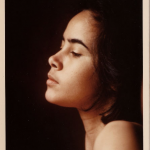
Esmeralda Santiago, author of novels and memoirs, arrived in the U.S. from Puerto Rico at the age of 13.
“Migration is a fundamental human activity,” begins Roger Daniels in his book, Coming to America: A History of Immigration and Ethnicity in American Life. Although common, migration and immigration can be difficult. The “second generation” — those who immigrated as children or who were born in the U.S. to immigrant parents — often face unique challenges which cut across cultures. First-generation immigrant Americans tend to have strong ties to the country they came from, yet consciously chose to come to the United States. Their children, on the other hand, often have weak ties to the ancestral country and had no choice about being raised in the United States.

William Saroyan, a playwright, short story writer, and novelist, was born and raised in California. His parents were immigrants from Armenia.
The study of immigrant literature often throws first-generation immigrant writers into the same category as their children. In fact, the children of immigrants, second-generation Americans, may have very different perspectives from their parents.
According to the most recent Census report on the issue (from 2013), about 12% of U.S. born people have at least one foreign-born parent. A Pew Research Center report projects that this percentage will grow to 18% by 2050.
Studying literature by second-generation Americans can highlight the transition from immigrant to American. As Marina Budhos notes in her book Remix: Conversations with Immigrant Teenagers: “Immigrant teenagers often don’t have any in-between space where they can work out the pressures of their in-between lives” (p. 10). For the second generation, their lives seem in-between –- they don’t identify completely with the home culture or with American culture.
Julia Alvarez, who immigrated from the Dominican Republic as a child, titled her first book How the Garcia Girls Lost Their Accents. The second generation typically loses their “foreign” accent and begins to speak like the Americans around them, but the first generation, those who came here as adults, typically don’t lose their accent. They retain their identification with the ancestral culture even in the way they speak.
This web site explores fiction and memoir written by second-generation authors in the United States. The transition from immigrant to American is one of the foundational stories of America. Studying second generation literature can help us understand how this transition happens, in all its variety, as well as what it means to be American.
If you would like to suggest additional authors or titles for this web site, please contact me at: jyotsna1sree [at] gmail [dot] com
The following reference books were very helpful in putting together this web site:
- Becoming Americans: Four Centuries of Immigrant Writing
edited by Ilan Stavans
- The Greenwood Encyclopedia of Asian American Literature [3 volumes]
edited by Guiyou Huang
- The Immigrant Experience in American Fiction: An Annotated Bibliography
by Roberta Simone
- The Immigrant Experience in North American Literature: Carving Out a Niche
edited by Katherine B. Payant and Toby Rose
- New Immigrant Literatures in the United States: A Sourcebook to Our Multicultural Literary Heritage
edited by Alpana Sharma Knippling
About Jyotsna Sreenivasan: I am a second generation American (my parents are immigrants from India). My short story collection, These Americans, includes 8 short stories and a novella about Indian-Americans. My novel And Laughter Fell from the Sky is about two twenty-something Indian-Americans trying to find love and their place in the world. My book Aruna’s Journeys
is an autobiographical novel for middle-grade readers about an Indian-American girl’s search for identity.


As the daughter of a Bolivian immigrant I have been searching desperately for a platform that explores what it is like to be a second generation immigrant and feel disconnected from your roots but in now way fully “American”. I am also looking to explore my multicultural experience through writing and have a blog and a series titled “No Hablo Espanol” about my experience growing up in a multicultural household with my immigrant father and American mother. Would love to chat and learn more about your experience!